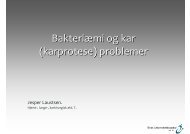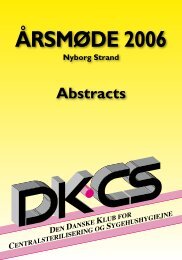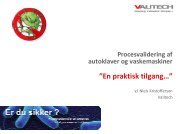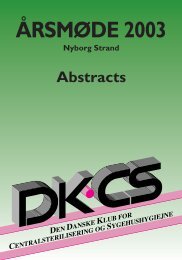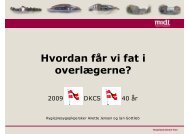Årsmøde 2005- Abstract - DKCS
Årsmøde 2005- Abstract - DKCS
Årsmøde 2005- Abstract - DKCS
Create successful ePaper yourself
Turn your PDF publications into a flip-book with our unique Google optimized e-Paper software.
particle count in the surrounding air ie the background count, we obtained percentage<br />
readings, which gave predictable and unpredictable efficiency results !!<br />
Full details of the test would form a separate presentation and has been presented to<br />
the UK Central Sterilisation Club and submitted for publication in a European Journal.<br />
Typical results with single envelope packaging are shown.These results predictably<br />
show Linen as a poor barrier. SMS types (Choice Wrap) as a good barrier. Wet<br />
laids and crepe paper as poor performers !In the case of Choice wrap, we know that<br />
Choice Dry has a higher barrier level (more melt fibres) than the standard Choice<br />
wrap and our test is picking up this difference. The SMMS product tested, we suspect<br />
had two very light weight melt fibre layers giving inferior filtration compared to the<br />
Choice products.<br />
It is interesting to note that the Purple transportation wrap, under the conditions of<br />
test, performs better than the ‘approved‘ wet laids and crepe paper !!! We, therefore,<br />
decided to change the folding techniques and modified the folding. This additional<br />
tuck under is often used when two layer / simultaneous packing is used. Again the<br />
results were surprising. Choice Wraps changed very little and remained superior. Wet<br />
laids changed very little but remained inferior! Crepe, however, and reinforced crepes<br />
improved considerably.<br />
PARTICLE PENETRATION TEST.<br />
In order to try and understand this even further we decided to develop a new test<br />
capable of testing just the particle penetration through the wraps and eliminate the<br />
variations created by different folding techniques. This has led us to develop our particle<br />
tester, with an inverted pyramid to which we can seal a 50 x 50 cm test sheet.<br />
Again the results are in the same order as before, with Choice Dry and Choice at the<br />
top and the wet laids at the bottom !!!!<br />
Crepe paper is constructed of pure cellulose. These fibres can be fibrillated, less so in<br />
reinforced crepe. Additional folding and layers will enhance the performance of pure<br />
cellulose products. This certainly accounts for the poor results in the pack integrity<br />
test. Choice Dry and Choice Wraps are produced with strong spun bonded fibres and<br />
enclose the very much finer Melt blown fibres. These melt blown fibres are extremely<br />
fine and discontinuous. With good dispersion and in the right quantity, these provide<br />
excellent filtration with rapid penetration of gasses , just what is needed for the<br />
autoclaving process and for maintaining sterility.<br />
Transportation wraps, based totally on spun polypropylene fibre will vary greatly<br />
depending on the fibre denier and formation , but some filtration effect is provided<br />
and possibly superior to crepe papers , when folded and used as a wrap .<br />
DOUBLE LAYERS<br />
Under the particle penetration test , the air can only pass through the product and not<br />
escape through folds as in the pack integrity test, but the pattern remains the same .<br />
Again the Choice and Choice Dry changed ver little as the spun in a single layer performs<br />
so well. Wet laids still remain the worst performers.<br />
BACK TO PACK INTEGRITY<br />
Our work is clearly showing the superiority of our Choice and Choice Dry material .<br />
Gaseous penetration is excellent and the performance of one layer very little improved<br />
by adding a second layer. Therefore, we conclude that an inner layer of Choice or<br />
Choice Dry and one outer layer of Purple Transportation Wrap will provide excellent<br />
barrier protection of the inner wraps and excellent handling properties of the outer<br />
transportation wrap .<br />
PACK INTEGRITY – A FINAL THOUGHT<br />
The Clinipak Pack Integrity test can offer departments a means of rating the packing<br />
method adopted, by offering numeric comparisons and ensuring that any changes<br />
made are improvements over the current practices. This could be very valuable when<br />
making changes for cost or protection reasons and to offer reassurance to theatres or<br />
other end user groups that the changes made are working and effective.<br />
27



